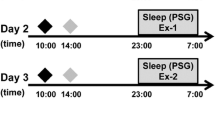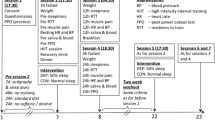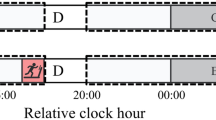Summary
Eight army recruits were studied at the start, middle, and end of their initial 18-week training programme. At each point the subjects were studied for four consecutive nights in the sleep laboratory. Their sleep was characterized by the means of the recordings on the last two nights. Within 2 days of the sleep recordings (but never on the same day) each subject spent 2 non-consecutive days in the exercise laboratory. On the 1st day a maximum oxygen consumpton (\(\dot V_{{\text{O}}_{\text{2}} }\) max) measurement was performed on a treadmill and on the 2nd day a 24-min progressive exercise bicycle ergometer test was carried out with simultaneous venous sampling (for lactic acid measurements) and oxygen consumption recordings from which the lactate turn point (LTP) was calculated. LTP was used as a measure of fitness. Approximately 1 week after the above measures lean muscle mass as calculated by total body potassium estimation was obtained for each subject. Slow wave sleep (SWS) as a percentage of total sleep time increased significantly between the start and the measurements at 9 and 18 weeks, being 21.9%, 29.9%, and 28.5% respectively. Anaerobic threshold increased significantly (P<0.05) over the first 9 weeks and continued to increase to the end of the training period (P<0.001) using\(\dot V_{{\text{O}}_{\text{2}} }\) when lactate level was 2 mmol/l as a percentage of\(\dot V_{{\text{O}}_{\text{2}} }\) max. With increase in fitness, sleep onset latency and wake time during sleep decreased and sleep efficiency improved. The results suggest that as fitness increases sleep quality improves.
Similar content being viewed by others
References
Adam K (1980) Dietary habits and sleep after bedtime food drinks. Sleep 3: 47–58
Adolfsson J, Ljungqvist A, Tornling G, Unge G (1981) Capillary increase in the skeletal muscle of trained young and adult rats. J Physiol 310: 529–532
Agnew HW, Webb WB, Williams RL (1966) The first night effect: an EEG study of sleep. Psychophysiol 2: 263–266
Astrand I, Rodahl K (1970) Textbook of Work Physiology. McGraw Hill, New York
Baekeland F (1970) Exercise deprivation: sleep and psychological reactions. Arch Gen Psychiat 22: 365–369
Baekeland F, Lasky R (1966) Exercise and sleep pattern in college athletes. Percept Motor Skills 23: 1203–1207
Boddy K, King PC, Tothill P, Strong JA (1971) Measurement of total body potassium with a shadow shield whole body counter: calibration and errors. Phys Med Biol 16: 275–282
Borbely AA, Baumann F, Brandeis D, Strauch I, Lehman D (1981) Sleep deprivation: effect on sleep stages and EEG power density in man. Electroenceph Clin Neurophysiol 51: 483–493
Buguet A, Roussel B, Angus R, Sabiston B, Radomski M (1980) Human sleep and adrenal individual reactions to exercise. Electroenceph Clin Neurophysiol 49: 515–523
Flenly DC, Brash H, Clancy L, Cooke NJ, Leitch AG, Middleton W, Wraith PK (1979) Ventilatory response to steady-state exercise in hypoxia in humans. J Appl Physiol 46: 438–446
Griffin SJ, Trinder J (1978) Physical fitness exercise and human sleep. Psychophysiol 15: 447–450
Hauri P (1968) Effects of evening activity on early night sleep. Psychophysiol 4: 267–277
Hinkley DV (1969) Interference about the intersection in two phase regression. Biometrika 56: 495–504
Horne JA, Porter JM (1975) Exercise and human sleep. Nature 256: 573–575
Oswald I (1980) Sleep as a restorative process: human clues. Prog Brain Res 50: 1279–287
Rechtschaffen A, Kales A (1968) A manual of standardized terminology, techniques and scoring system for sleep stages of human subjects. Government Printing Office, Washington, DC
Saltin B (1969) Physiological effects of physical conditioning. Med Sci Sports 1: 50–56
Shapiro CM (1981) Sleep and the athlete. Br J Sports Med 15: 51–55
Shapiro CM, Bortz R, Mitchell D, Bartel P, Jooste P (1981) Slow wave sleep: a recovery period after exercise. Science 214: 1253–1254
Shapiro CM, Griesel RD, Bartel PR, Jooste PL (1975) Sleep patterns after graded exercise. J Appl Physiol 39: 187–190
Snedecor GW, Cochran WG (1971) Statistical methods. The Iowa State University Press, Ames, Iowa
Walker JM, Floyd TC, Fein G, Cavness C, Lualhati R, Feinberg I (1978) Effects of exercise on sleep. J Appl Physiol 44: 945–951
Williams CG, Wyndham CH, Kok R, von Rahden MJE (1967) Effect of training on maximum oxygen intake and on anaerobic metabolism in man. Int Z Angew Physiol 24: 18–23
Zloty RB, Burdick JA, Adamson JD (1973) Sleep of distance runners. Act Nerv Super 15: 217–221
Author information
Authors and Affiliations
Rights and permissions
About this article
Cite this article
Shapiro, C.M., Warren, P.M., Trinder, J. et al. Fitness facilitates sleep. Europ. J. Appl. Physiol. 53, 1–4 (1984). https://doi.org/10.1007/BF00964680
Accepted:
Issue Date:
DOI: https://doi.org/10.1007/BF00964680




